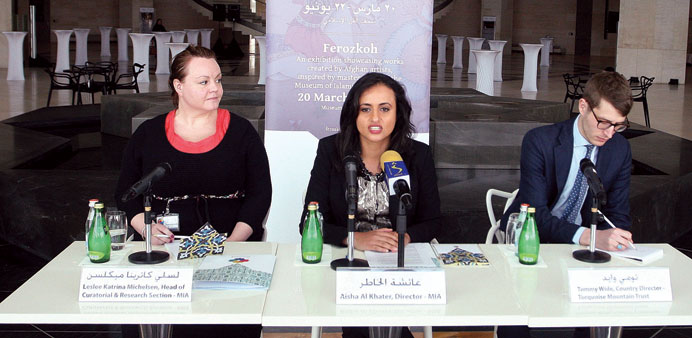The richness of Afghan cultural heritage is on show at ‘Ferozkoh: Tradition and Continuity in Afghan Art,’ a unique exhibition which opens today at Museum of Islamic Art’s temporary gallery on ground floor.
“This exhibition is the result of a partnership between MIA and the Turquoise Mountain Institute for Afghan Arts and Architecture (TMI) in Kabul,” MIA director Aisha al-Khater said yesterday.
The unifying theme of the exhibition, which runs until June 22, is the preservation of the traditional arts of the Islamic world – in both themes and materials – in the modern world, and the role of education in its transmission and translation.
The exhibition features 37 historical objects from MIA’s collection - the products of four great dynasties with connections to Afghanistan: the Ghaznavids (977-1186 CE), Timurids (1370-1506 CE), Mughals (1526-1857 CE) and Safavids (1501-1722 CE), and 37 contemporary pieces created for the show by TMI students, who drew inspiration from the former.
“A group of 16 students and teachers from Kabul spent two weeks in Doha last June examining the historical pieces and then went back and embarked on a mission to create the contemporary artworks,” explained exhibition curator Dr Leslee Michelsen, head of MIA’s Curatorial and Research Section and a specialist in the arts of Medieval Iran and Central Asia.
Most of the TMI students, who are highly skilled craftspeople, had only seen such historical pieces as pictures on a screen, or pages in a book. The MIA staff also assisted by discussing the techniques and history of the objects. In short, the visit created a dialogue between past and present, old and new, the richness of tradition and the vibrancy of modern Afghanistan.
An elephant miniature has been painted, inspired by an exquisite gold armlet from 10th to 11th century Central Asia, and connected by the technique of their manufacture: granulation, whether of gold or of tiny drops of paint.
The “cloud band” motif of a 15th century dish has been interpreted through a pendant. The lozenge motif of a 17th century Mughal carpet is echoed in a hand-carved Nuristani panel, whereas the delicate openwork of a 17th century sphere has inspired the margin decoration of the contemporary Qur’an.
The partnership with TMI is in line with the vision of Qatar Museums Authority chairperson HE Sheikha al-Mayassa bint Hamad bin Khalifa al-Thani, to make the MIA “a platform for positive community involvement with the cultural heritage of the past, as well as the present.”
‘Ferozkoh: Tradition and Continuity in Afghan Art’ is a part of the Qatar UK 2013 Year of Culture, given that TMI has the Prince of Wales as its patron and founder. TMI was established in March 2006, also with the support of Afghanistan President Karzai, with the aim of regenerating historic urban areas, renewing Afghan traditional arts and architecture, and spurring the sustainable development of the nation’s craft industry.
The exhibition timings: Sunday, Monday, Wednesday – 10.30am to 5.30pm; Thursday, Saturday - noon to 8pm; Friday - 2pm to 8pm. Last admission is 30 minutes before closing. Entry fee - QR25 (free on Mondays and for children under 16 years). Flash photography in not allowed in the exhibition.

Aisha al-Khater flanked by Dr Leslee Michelsen and Turquoise Mountain Trust country director Tommy Wide. PICTURES: Anas Khalid
